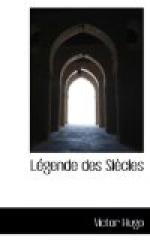Hugo omitted from his adaptation two incidents of great poetic interest, namely, the picture of Aude watching the fight, and the miraculous intervention of the angel. He has, on the other hand, inserted the barbaric incident of the fight with trees. He has eliminated, that is to say, the tender and the religious elements from the story and made it simply the narrative of a Homeric combat, with more than a touch of the grotesque. Nevertheless, he has retained the characteristic incident of the chivalrous behaviour of Roland in sending for a new sword for his enemy and in giving him time for rest, a trait which finds a parallel in many other Chansons, notably in the story of the battle of Roland with Ferragus, a Saracen giant. When Ferragus is worn out with fighting, Roland watches over him while he sleeps, and on his awakening enters into a theological discussion with him in the hope of converting him to Christianity. When this pious desire fails, the combat is renewed.
Saint Michael is described in Rev. xii. 7-9 as fighting against Satan and casting him out of heaven.
Hugo is mistaken in his description of Olivier, who was not lord of Vienne and a sovereign count, but only the son of Renier, duke of Genoa. The only statement in these two lines which is correct is that his grandfather was Garin.
L. 27. As already noted, in the original story it is an aged Jew who arms Olivier for the fight.
Rollon (English Rollo) was the Norse pirate who invaded France in A.D. 912 and founded the Duchy of Normandy. The reference to him is of course an anachronism.
estoc (c pronounced), a long narrow sword used for thrusting.
cimier (from Latin cyma, the young sprout of a cabbage), the crest on the helmet.
Roland’s sword, Durandal, which was given him by Charlemagne, plays the same part in the French Chansons as Siegfried’s sword Balmung in the Nibelunglied, or Excalibur in the Arthurian cycle. Other forms of the name are Durendas, Durrenda, Durandarda.
en franc neveu du roi, like a real or genuine nephew of the king.
Tournon, a town situated on the right bank of the Rhone, in the department of Ardeche. It still produces a well-known wine, called Vins de l’Ermitage.
1. 70. Here is a curious mistake, which Jubinal originated and Hugo copied. Closamont was the original possessor of the sword, not another name for the weapon. The lines in the ’Chanson de Girart de Viane’ are:—
Une en aporte ke molt fut onoree. plus de c. anz l’ot li iuis gardee, Closamont fut, k’iert de grand renommee, li emperere de Rome la loee.
Sinnagog or Sinnagos was the Saracen king of Alexandria with whose attack on the castle of Garin, Olivier’s grandfather, the story of ‘Girart de Viane’ begins.




